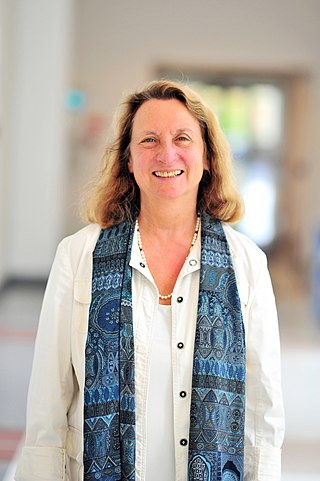
Fortran is a third generation, compiled, imperative programming language that is especially suited to numeric computation and scientific computing.

The GNU Compiler Collection (GCC) is a collection of compilers from the GNU Project that support various programming languages, hardware architectures and operating systems. The Free Software Foundation (FSF) distributes GCC as free software under the GNU General Public License. GCC is a key component of the GNU toolchain which is used for most projects related to GNU and the Linux kernel. With roughly 15 million lines of code in 2019, GCC is one of the largest free programs in existence. It has played an important role in the growth of free software, as both a tool and an example.
Scientific notation is a way of expressing numbers that are too large or too small to be conveniently written in decimal form, since to do so would require writing out an inconveniently long string of digits. It may be referred to as scientific form or standard index form, or standard form in the United Kingdom. This base ten notation is commonly used by scientists, mathematicians, and engineers, in part because it can simplify certain arithmetic operations. On scientific calculators, it is usually known as "SCI" display mode.

Boric acid, more specifically orthoboric acid, is a compound of boron, oxygen, and hydrogen with formula B(OH)3. It may also be called hydrogen orthoborate, trihydroxidoboron or boracic acid. It is usually encountered as colorless crystals or a white powder, that dissolves in water, and occurs in nature as the mineral sassolite. It is a weak acid that yields various borate anions and salts, and can react with alcohols to form borate esters.
The Damköhler numbers (Da) are dimensionless numbers used in chemical engineering to relate the chemical reaction timescale to the transport phenomena rate occurring in a system. It is named after German chemist Gerhard Damköhler, who worked in chemical engineering, thermodynamics, and fluid dynamics. The Karlovitz number (Ka) is related to the Damköhler number by Da = 1/Ka.
Chemical kinetics, also known as reaction kinetics, is the branch of physical chemistry that is concerned with understanding the rates of chemical reactions. It is different from chemical thermodynamics, which deals with the direction in which a reaction occurs but in itself tells nothing about its rate. Chemical kinetics includes investigations of how experimental conditions influence the speed of a chemical reaction and yield information about the reaction's mechanism and transition states, as well as the construction of mathematical models that also can describe the characteristics of a chemical reaction.
Ratfor is a programming language implemented as a preprocessor for Fortran 66. It provides modern control structures, unavailable in Fortran 66, to replace GOTOs and statement numbers.
Chemical physics is a branch of physics that studies chemical processes from a physical point of view. It focuses on understanding the physical properties and behavior of chemical systems, using principles from both physics and chemistry. This field investigates physicochemical phenomena using techniques from atomic and molecular physics and condensed matter physics.

A chemical reactor is an enclosed volume in which a chemical reaction takes place. In chemical engineering, it is generally understood to be a process vessel used to carry out a chemical reaction, which is one of the classic unit operations in chemical process analysis. The design of a chemical reactor deals with multiple aspects of chemical engineering. Chemical engineers design reactors to maximize net present value for the given reaction. Designers ensure that the reaction proceeds with the highest efficiency towards the desired output product, producing the highest yield of product while requiring the least amount of money to purchase and operate. Normal operating expenses include energy input, energy removal, raw material costs, labor, etc. Energy changes can come in the form of heating or cooling, pumping to increase pressure, frictional pressure loss or agitation.
CHEMKIN is a proprietary software tool for solving complex chemical kinetics problems. It is used worldwide in the combustion, chemical processing, microelectronics and automotive industries, and also in atmospheric science. It was originally developed at Sandia National Laboratories and is now developed by a US company, Reaction Design.

Selected-ion flow-tube mass spectrometry (SIFT-MS) is a quantitative mass spectrometry technique for trace gas analysis which involves the chemical ionization of trace volatile compounds by selected positive precursor ions during a well-defined time period along a flow tube. Absolute concentrations of trace compounds present in air, breath or the headspace of bottled liquid samples can be calculated in real time from the ratio of the precursor and product ion signal ratios, without the need for sample preparation or calibration with standard mixtures. The detection limit of commercially available SIFT-MS instruments extends to the single digit pptv range.
COSILAB is a software tool for solving complex chemical kinetics problems. It is used worldwide in research and industry, in particular in automotive, combustion, and chemical processing applications.

AutoChem is NASA release software that constitutes an automatic computer code generator and documenter for chemically reactive systems written by David Lary between 1993 and the present. It was designed primarily for modeling atmospheric chemistry, and in particular, for chemical data assimilation.
The Kinetic PreProcessor (KPP) is an open-source software tool used in atmospheric chemistry. Taking a set of chemical reactions and their rate coefficients as input, KPP generates Fortran 90, FORTRAN 77, C, or Matlab code of the resulting ordinary differential equations (ODEs). Solving the ODEs allows the temporal integration of the kinetic system. Efficiency is obtained by exploiting the sparsity structures of the Jacobian and of the Hessian. A comprehensive suite of stiff numerical integrators is also provided. Moreover, KPP can be used to generate the tangent linear model, as well as the continuous and discrete adjoint models of the chemical system.
Chemical WorkBench is a proprietary simulation software tool aimed at the reactor scale kinetic modeling of homogeneous gas-phase and heterogeneous processes and kinetic mechanism development. It can be effectively used for the modeling, optimization, and design of a wide range of industrially and environmentally important chemistry-loaded processes. Chemical WorkBench is a modeling environment based on advanced scientific approaches, complementary databases, and accurate solution methods. Chemical WorkBench is developed and distributed by Kintech Lab.

Reaction Design is a San Diego-based developer of combustion simulation software used by engineers to design cleaner burning and fuel-efficient combustors and engines, found in everything from automobiles to turbines for power generation and aircraft propulsion to large diesel engines that use pistons the size of rooms to propel ships locomotives. The technology is also used to model spray vaporization in electronic materials processing applications and predict mixing reactions in chemical plants. Ansys, a leader in engineering simulation software, acquired Reaction Design in January 2014.
Combustion models for CFD refers to combustion models for computational fluid dynamics. Combustion is defined as a chemical reaction in which a fuel reacts with an oxidant to form products, accompanied with the release of energy in the form of heat. Being the integral part of various engineering applications like: internal combustion engines, aircraft engines, rocket engines, furnaces, and power station combustors, combustion manifests itself as a wide domain during the design, analysis and performance characteristics stages of the above-mentioned applications. With the added complexity of chemical kinetics and achieving reacting flow mixture environment, proper modeling physics has to be incorporated during computational fluid dynamic (CFD) simulations of combustion. Hence the following discussion presents a general outline of the various adequate models incorporated with the Computational fluid dynamic code to model the process of combustion.

Elaine Surick Oran is an American physical scientist and is considered a world authority on numerical methods for large-scale simulation of physical systems. She has pioneered computational technology to solve complex reactive flow problems, unifying concepts from science, mathematics, engineering, and computer science in a new methodology. An incredibly diverse range of phenomena can be modeled and better understood using her techniques for numerical simulation of fluid flows, ranging from the tightly grouped movements of fish in Earth's oceans to the explosions of far-flung supernovae in space. Her work has contributed significantly to the advancement of the engineering profession.
Chemical reaction models transform physical knowledge into a mathematical formulation that can be utilized in computational simulation of practical problems in chemical engineering. Computer simulation provides the flexibility to study chemical processes under a wide range of conditions. Modeling of a chemical reaction involves solving conservation equations describing convection, diffusion, and reaction source for each component species.







